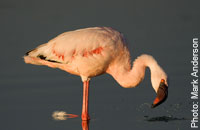National Action Plan for the Lesser Flamingo finalized in the Republic of Tanzania
 19
19
February 2010 - During a consultative meeting, organised
by the National Wetlands Working Group led by the Wildlife
Conservation Society of Tanzania (WCST) and the Tanzania
Wildlife Research Institute with support from the Wetlands
Unit of Tanzania's Wildlife Division, participants agreed
on a new National Single Species Action Plan for the Lesser
Flamingo (Phoeniconaias minor) for Tanzania. The
National Action Plan is based on the International Single
Species Action Plan for the conservation of the Lesser Flamingo
which was finalized under the auspices of AEWA and CMS.
Both plans aim to downgrade the Lesser Flamingo from a
“Near-Threatened” species to a species of “Least
Concern” on the IUCN Red List of Threatened Species.
Identified activities in these plans focus on measures to
address the major threats to the survival of the species
and to fill current knowledge gaps. These measures include
protecting the Lesser Flamingo and its habitats and increasing
public awareness as well as appropriate management of key
sites.
Because of its specialized diet of microscopic alkaline
cyanobacteria (‘blue green algae’), the Lesser
Flamingo is totally dependent on a habitat of shallow saline/alkaline
lakes, pans, wetlands and coastal areas. It occurs regularly
in 30 countries from West Africa, across sub-Saharan Africa
and along the southwest Asian coast to South Asia. One of
these countries is the Republic of Tanzania, where Lake
Natron is by far the most important breeding site for the
species worldwide. Plans for a proposed soda extraction
facility around Lake Natron attracted global attention,
because soda ash processing represents a potentially serious
threat to the survival of the entire species.
For more information please visit:
- International
Single Species Action Plan for the Conservation of the
Lesser Flamingo (Phoeniconaias minor)
Last updated on 16 June 2014


